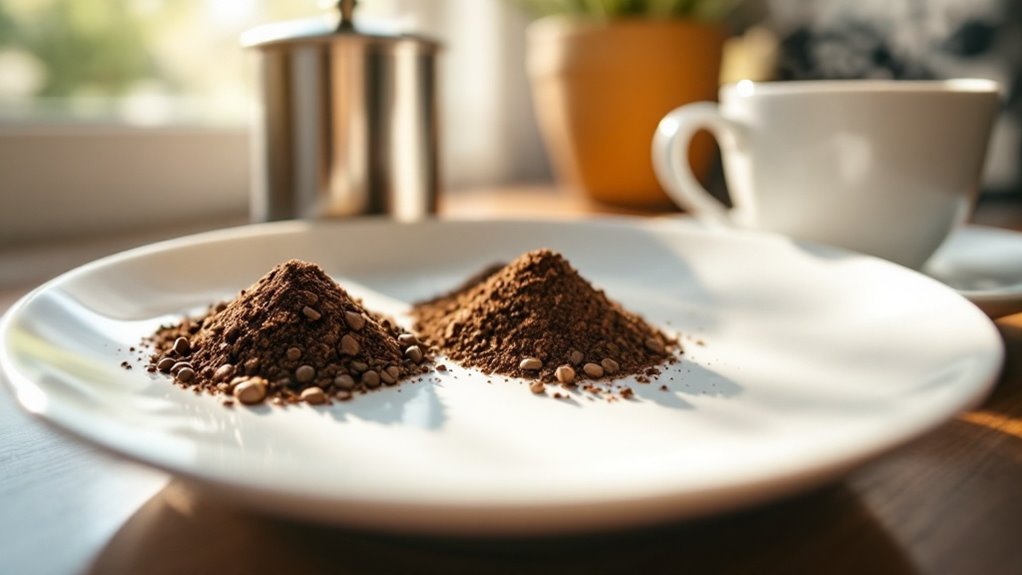







When you sip a cup of coffee, acidity is often what gives it that bright, lively edge—think citrusy tang or a hint of berry. It's not just about sourness; acidity balances sweetness and bitterness, shaping the overall flavor profile. But why do some coffees taste zesty while others feel mellow? The answer lies in factors like bean origin, roast level, and brewing technique. Understanding how acidity works can transform the way you experience coffee, but there's more to uncover about how it interacts with other elements to create that perfect cup.
Key Takeaways
- Coffee acidity adds bright, tangy, or fruity notes, enhancing flavor complexity and balance in the cup.
- It offsets bitterness and complements sweetness, creating a harmonious and dynamic taste experience.
- Acidity varies by origin, with African coffees often showcasing citrus or berry-like acidity compared to smoother South American varieties.
- Light roasts retain more acidity, preserving vibrant, fruity flavors, while dark roasts mellow acidity for richer, caramelized profiles.
- Brewing methods like espresso emphasize acidity, while cold brew reduces it, offering smoother, less acidic coffee options.
Understanding Coffee Acidity Basics
Acidity in coffee is a fundamental aspect of its flavor profile, characterized by bright, tangy, or sharp sensations that enhance its complexity and balance. When you taste coffee, acidity refers to the lively, vibrant notes that cut through the richness, often described as fruity, citrusy, or wine-like. This ACIDITY IN COFFEE isn't the same as sourness; instead, it's a desirable quality that complements sweetness and offsets bitterness. The level of acidity varies depending on the coffee beans, their origin, and how they're processed. Light roasts typically retain more acidity, while dark roasts lose some due to the breakdown of acids during prolonged roasting. The acidity of coffee is measured by pH levels, which typically range from 4.85 to 5.10, making it slightly acidic compared to water. Understanding this balance helps you appreciate how acidity contributes to the overall sensory experience, making each cup unique. By recognizing the role of acidity, you can better identify and enjoy the nuanced flavors in your coffee.
Factors Influencing Coffee Acidity
Several key factors shape the acidity in your coffee, each contributing to its distinct flavor profile. Coffee bean origin plays a significant role, as beans from regions like Ethiopia often exhibit higher acidity compared to those from South America. Roast level also impacts acidity; light roasts preserve more acidic compounds, while dark roasts tend to mellow them out. Brewing temperature further influences acidity extraction, with higher temperatures pulling more acidic elements from the grounds. Water pH is another critical factor, as alkaline water can neutralize sharp acidic notes, altering the perceived flavor. Finally, processing methods determine acidity levels; washed coffees typically retain more acidity than natural or honey-processed beans, which develop sweeter, less acidic profiles. By understanding these variables—coffee bean origin, roast level, brewing temperature, water pH, and processing methods—you can better control and appreciate the acidity in your cup. Each factor interacts uniquely, shaping the final taste and ensuring no two brews are exactly alike.
How Acidity Shapes Coffee Flavor
Acidity enhances coffee's flavor complexity by introducing bright, tangy, or fruity notes that elevate its sensory profile. It balances bitterness and sweetness, creating a harmonious taste experience that feels vibrant in high-acid coffees and mellow in low-acid ones. Your perception of acidity also shifts with origin, as African coffees often highlight pronounced acidity, while Brazilian or Sumatran varieties lean toward smoother, less acidic profiles.
Acidity Enhances Flavor Complexity
A key element that transforms coffee from a simple beverage into a complex sensory experience is its acidity. Acidity enhances flavor complexity by introducing bright, tangy, and fruity notes that interact with sweetness and bitterness to create a dynamic profile. High-acidity coffees, such as those from Ethiopia or Kenya, often showcase vibrant citrus, berry, or wine-like flavors, which are driven by the presence of acids like citric acid, malic acid, and phosphoric acid. Citric acid contributes zesty, lemon-like brightness, while malic acid adds apple-like tartness. Phosphoric acid, though less common, imparts a sparkling, almost effervescent quality. These acids work in harmony to layer flavors, making each sip more intricate and engaging. The interplay of these acids doesn't just add sharpness; it elevates the coffee's overall structure, creating a lively and invigorating palate. When balanced, acidity guarantees the coffee feels vibrant without overwhelming the senses, enhancing its depth and making it more enjoyable. This complexity is what distinguishes a memorable cup from a mundane one.
Balancing Acidity and Sweetness
Balancing acidity and sweetness in coffee creates a harmonious interplay that defines its flavor profile. Acidity enhances sweetness by counteracting bitterness, guaranteeing a well-rounded taste experience. In high-acidity coffees, such as those from Ethiopia or Kenya, fruity notes like citrus or berry complement the natural sweetness, adding vibrancy and complexity. Arabica beans, often grown at high altitudes, naturally exhibit this balance, with their bright acidity highlighting inherent sugars. Proper extraction is critical; underextraction leads to excessive sourness, while overextraction results in bitterness, disrupting the equilibrium. Light to medium roasts preserve acidity, allowing the sweetness to shine without overpowering the cup. When acidity and sweetness are in harmony, they create a dynamic flavor profile that's both invigorating and satisfying. This balance is particularly evident in coffees with pronounced fruity notes, where acidity acts as a counterpoint to sweetness, enhancing the overall sensory experience. By understanding how acidity interacts with sweetness, you can better appreciate the nuanced flavors in your cup, especially when brewing high-quality Arabica beans. Achieving this balance guarantees a coffee that's neither overly sharp nor cloyingly sweet, but perfectly poised.
Acidity's Impact on Taste Perception
The tangy burst of a lemon or the sharpness of green apple can mirror the way acidity shapes coffee's flavor profile. Acidity enhances brightness and liveliness, introducing citrus, berry, or wine-like notes that elevate the sensory experience. When balanced, acidity complements sweetness and mitigates bitterness, creating a harmonious interplay that defines taste perception. High acidity often delivers a crisp, tangy sensation, described as vibrant or sharp, which can amplify the perceived complexity of the coffee. However, overly high acidity risks sourness, while low acidity may result in a flat or dull flavor, diminishing the overall experience. The level of acidity directly influences the coffee's character, with lighter roasts and specific origins like Ethiopian or Kenyan beans typically showcasing higher acidity. This contributes to a dynamic flavor profile that engages your palate. Understanding how acidity interacts with other elements—sweetness, bitterness, and body—helps you appreciate its role in crafting a well-rounded cup. Balanced acidity guarantees that the coffee remains lively without overwhelming, striking a delicate equilibrium that defines exceptional flavor.
Roasting's Impact on Coffee Acidity
Roast time and temperature directly shape coffee acidity, with lighter roasts preserving bright, fruity notes by retaining higher acid levels. Darker roasts reduce acidity as prolonged heat breaks down chlorogenic acid, yielding smoother, caramelized flavors. To balance acidity, you must carefully control roasting parameters, avoiding over-roasting that flattens flavors or under-roasting that leaves coffee overly sour.
Roast Time and Acidity
When it comes to shaping coffee's acidity, roast time plays a critical role in determining the final flavor profile. Lighter roasts, with shorter roast times, retain higher levels of chlorogenic acids, which contribute to a brighter, more pronounced perceived acidity. These roasts often highlight fruity, floral, and complex notes, making them ideal for those seeking vibrant flavors. Conversely, longer roast times break down chlorogenic acids, reducing acidity and creating smoother, caramelized flavors. Over-roasting, however, can dull acidity excessively, resulting in flat or overly bitter profiles, while under-roasting may leave coffee tasting sour or grassy. Medium roasts strike a balance, offering moderate acidity with enhanced sweetness and body compared to lighter roasts. The interplay between roast time and temperature also matters: higher temperatures for shorter durations can emphasize acidity, while lower temperatures over extended periods tend to mellow it. By carefully controlling roast time, you can manipulate acidity to achieve the desired balance of brightness, sweetness, and complexity in your coffee.
Light vs. Dark Roasts
Light and dark roasts showcase distinct acidity profiles shaped by their roasting processes. Light roasts retain higher levels of acidity due to shorter roasting times, preserving chlorogenic acids that contribute to bright, fruity, and citrusy flavor notes. These roasts emphasize vibrant, tangy characteristics, making them ideal for those who enjoy a crisp, lively cup. In contrast, dark roasts undergo prolonged exposure to higher temperatures, which breaks down chlorogenic acids and reduces acidity. This results in smoother, chocolaty profiles with muted brightness, appealing to those who prefer deeper, richer flavors. The roast level directly impacts perceived acidity, with light roasts highlighting tangy, complex notes and dark roasts favoring bold, caramelized undertones. Medium roasts strike a balance, offering a harmonious blend of brightness and depth. By understanding how roasting affects acidity, you can better align your coffee preferences with the roast profile that suits your taste. Whether you crave the zesty punch of light roasts or the mellow richness of dark roasts, the interplay between acidity and roasting defines your coffee experience.
Acidity Preservation Techniques
Through careful control of time and temperature, roasters can preserve the vibrant acidity that defines high-quality coffee. To maintain higher acidity, you'll want to roast at lower temperatures for shorter durations, as this minimizes the breakdown of chlorogenic acids, which are key to bright, fruity flavors. Lighter roasts excel in preserving these acids, making them ideal for brewing methods like pour-over or AeroPress that highlight nuanced acidity. Medium roasts strike a balance, retaining some bright notes while developing caramelized flavors, suitable for methods like drip coffee. Dark roasts, however, markedly reduce acidity due to prolonged heat exposure, breaking down acids and yielding more bitter, chocolaty profiles. Over-roasting can dull acidity, resulting in a flat or overly bitter cup, while under-roasting may leave coffee with a sour or grassy taste. By tailoring the roast profile to the bean's origin and desired flavor, you can optimize acidity levels. High-altitude beans, known for their inherent higher acidity, particularly benefit from lighter roasts to preserve their citrusy and floral notes. Precision in roasting guarantees that the coffee's natural acids remain intact, enhancing its complexity and balance.
Brewing Methods and Acidity Levels
Brewing methods substantially influence the acidity levels in coffee, shaping its overall flavor profile. When you use higher brewing temperatures (195-205°F), you extract more acidity, which enhances bright and tangy flavors. This is particularly evident in methods like pour-over or espresso, where precise control over water flow and extraction time highlights these acidic notes. Conversely, cold brew methods, which rely on cold water and extended steeping times (12-24 hours), produce coffee with up to 70% less acidity, resulting in a smoother, mellower cup. French press brewing retains more oils and acids due to its metal filter, creating a fuller-bodied coffee with noticeable acidity. Espresso, with its high pressure and short extraction time, often emphasizes acidity, especially in lighter roasts. Each brewing method interacts differently with the coffee's chemical composition, directly impacting the acidity levels and, consequently, the flavor balance. By understanding how brewing methods affect acidity, you can tailor your approach to achieve the desired taste profile, whether you prefer a bright, acidic cup or a low-acid, smooth brew.
Types of Acids Found in Coffee
In the domain of coffee flavor, the types of acids present play a pivotal role in shaping the sensory experience. Citric acid, for instance, imparts bright, zesty notes reminiscent of citrus fruits, a hallmark of Ethiopian and Kenyan coffees. Malic acid contributes a crisp, green apple-like acidity, often found in Central American varieties, adding an invigorating sharpness. Tartaric acid, though less common, introduces a wine-like quality, typically associated with select African coffees, enhancing their complexity. Acetic acid, in low concentrations, delivers a tangy sharpness, but excessive levels can lead to a fermented taste, particularly in naturally processed beans. Phosphoric acid stands out for its ability to create a sparkling, effervescent acidity, elevating the overall flavor profile of specialty coffees. Each acid interacts uniquely with other compounds, influencing the balance, brightness, and depth of the brew. Understanding these acids allows you to appreciate how their concentrations and interactions define the distinct character of different coffee origins and processing methods. By recognizing their contributions, you gain insight into the intricate chemistry behind coffee's diverse flavor spectrum.
Choosing Coffees Based on Acidity Preferences
When selecting coffees based on acidity preferences, you'll find that the origin, roast level, and processing method substantially shape the flavor profile. If you enjoy bright, lively acidity, Central and South American coffees, such as those from Colombia or Costa Rica, deliver citrus and fruity notes. For a more adventurous palate, African coffees like Ethiopian or Kenyan varieties offer vibrant acidity with complex, wine-like flavors. If you prefer lower acidity, Indonesian or Sumatran coffees provide earthy, smooth profiles with minimal tanginess. Coffees from Brazil, especially medium-dark roasts, are excellent for balanced acidity, featuring chocolatey and nutty undertones. For those sensitive to acid, cold brew or naturally processed coffees are ideal, as they yield smoother, less sharp flavors. By understanding these differences, you can tailor your coffee choice to match your desired acidity level, ensuring a satisfying cup every time.
Disclosure: As an Amazon Associate, I earn from qualifying purchases.






